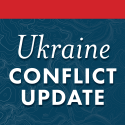Russian Offensive Campaign Assessment, March 11
Mar 11, 2022 - ISW Press
Russian ground forces attempting to encircle and take Kyiv began another pause to resupply and refit combat units on March 11 after failed attacks March 8-10. Russian forces also appear to be largely stalemated around Kharkiv. Russian advances from Crimea toward Mykolayiv and Zaporizhya and in the east around Donetsk and Luhansk made no progress in the last 24 hours, and Russian forces in the south face growing morale and supply issues. The Ukrainian General Staff asserted Russia has so far failed to take its territorial objectives for the war and will likely increasingly turn to strikes on civilian targets and psychological operations to undermine civilian support for the Ukrainian government. Uncoordinated and sporadic Russian offensive operations against major Ukrainian cities support the Ukrainian General Staff’s assessment that Russian forces face growing morale and supply issues and have lost the initiative. The Ukrainian General Staff stated on March 11 that Ukrainian forces are “actively defending and conducting successful counterattacks in all directions,” but did not state where reported counterattacks are occurring.










